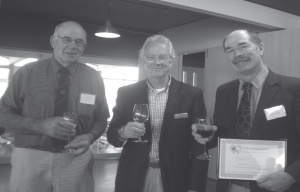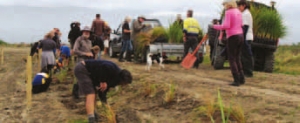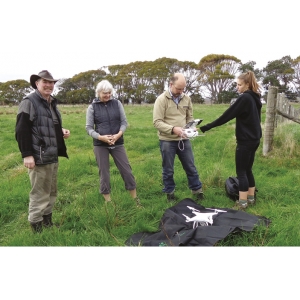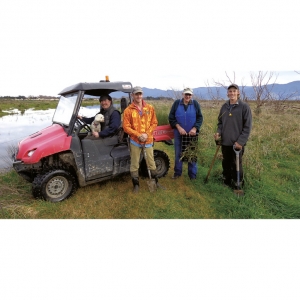Displaying items by tag: Wairio
Nikau Foundation grant for Wairio Wetland
A cheque for $6500 from the Nikau Foundation was handed over to Ducks Unlimited (DUNZ) President Ross Cottle and Patron Jim Campbell by Gus van de Roer of the Nikau Foundation to go towards the restoration of the Wairio Wetland.
Nikau Foundation Chairman Kevin O’Connor said he was delighted the Foundation was able to support Ducks Unlimited with its restoration work at the Wairio Wetland on the eastern shore of Lake Wairarapa.
While most grants had previously gone to Wellington based organisations he added that the Wairarapa is part of the wider community supported by the Foundation.
Ross Cottle said the grant would go towards site preparation and tree planting at the joint venture project with DOC.
“We are starting to see the results of four years of effort and this injection of funds will help maintain the momentum of the project,” said Ross.
Tree planting is planned for May/June and volunteers are welcome. In past years children from Pirinoa Primary School, students from the Taratahi Agricultural Training Centre, Rotarians and DU and F&B members have assisted with the planting.
Nikau Foundation is the community foundation for the Wellington region, part of a worldwide family that provides a simple, effective and long-lasting way for people to leave a gift for causes close to their heart and close to home. Because the capital is invested and only the income is given out, the gift
keeps on giving forever.
The grant for the Wairio Wetland restoration project has been arranged by Nikau on behalf of the Richard and Doreen Evans Trust.
Wetland vegetation focus of examination
The Wario Wetland has come in for some close scrutiny by Victoria University Student Bridget Johnson who is this year studying towards an MSc in Ecological Restoration. The overall title of her thesis is “Ecological restoration of the Wairio Wetlands, Lake Wairarapa: vegetation dynamics and succession”.
A Summer Scholarship meant she was able to do 10 weeks of research in her chosen field at Wario with the title for that part of her research being “Temporal & Spatial Patterns of Wetland Vegetation during the Summer Desiccation Period at Wairio Wetlands, Wairarapa”. In addition to the summer scholarship, Bridget has started preparing a second site at Wairio for a large scale experimental project where around 2400 trees have been planted.
The summer study programme provided an introduction to the Wairio Wetland for Bridget where she continues the research for her thesis on factors contributing to wetland restoration. Flight, with help from Jim Law, has been able to follow Bridget’s research so far.
A poster she produced she said was just a snap shot of some of that research. “Due to the limiting size of the poster, I only talked about rare species vulnerability.” All the summer scholars got to show their posters at a poster evening. Her poster included the following information plus a number of illustrations.
Introduction
Small in size, New Zealand’s native wetlands plant species are repeatedly outcompeted by more aggressive weeds. The surrounding vegetation invades when wetland plants are most vulnerable, during the desiccation (dry) period. A number of threatened low-lying plants (Pratia and Glosso) inhabit the Wairio Wetlands. To conserve these native plants a greater understanding is required of their optimal conditions and their spatial and temporal dynamics. “My aim was to investigate the temporal scale of the native species, and which abiotic factors affect their spatial distribution.”
Methods
Vegetation composition was sampled in 20 quadrants over a 10 week summer period. The quadrants were set five metres apart along two 50 metre perpendicular transects. The first transect followed a moisture gradient, whilst the other ran parallel. Additional abiotic variables were measured, such as soil moisture, soil pH, percentage open ground, sunshine hours and rainfall. Water Plantain was chosen as a comparative species as it is a common invader and an indicator of high soil moisture.
Discussion
The rare species are restricted to a small band of high moisture sites. A smaller number of invasive species can grow in these moist soils, so there are fewer competitors for the natives. In drier soils, the invasive species can spread easily, giving the vulnerable natives little chance of survival. This means the natives have truly specialised ecological requirements, as their time frame of existence and habitat preference is small. This is a contributing factor to what makes them vulnerable. Further research can be expanded from this study, for example: Should water plantain (and other invasive high moisture soil species) be managed to decrease the competition on the native species? Illustrations on the poster included Glasso, Pratia and Water plantain. Glosso and Pratia grow in soil with high moisture content and Water plantain grows more abundantly in high moisture soil but is adaptable to a greater variance of soil moisture. Bridget said the native species emerge later in the summer season, whereas water plantain is a consistent species. When the natives start emerging they have a higher percentage cover than the invasive water plantain.
“I would like to thank Dr Stephen Hartley, Tony Silbery (Department of Conservation Wairarapa), Jim Law (Ducks Unlimited) and Don Bell (Greater Wellington Regional Council) for their technical support,” said Bridget.
References: New Zealand Plant Conservation. 2010.
Enthusiasm and hard work for restoration
During the last weeks of June, a band of enthusiastic Wairio Wetland members and other helpers were involved in more planting at the wetland.
The Wairio Wetland Restoration Committee met back in May and agreed the last two weeks of June would be planting time and Don Bell (GWRC) would be requested to check on Warren Field's (DOC schools Co-ordinator), availability was well as the GWRC BBQ team. Attendees were expected to be two local primary schools (Pirinoa & Kahutara), plus South Featherston and Martinborough, students from Taratahi Agricultural Training College, Rotarians, DU members & others (eg F & B members).
Jim submitted a claim for an agreed payment by Rotary for the costs of the signage at stage 1 ($450). Additionally he made a further application to rotary for the cost of weed mats ($2200). both were approved by Rotary.
Bridget Johnson, the Masters student from the School of Biological Science at Victoria University was onsite supervising the digger scraping of planting test plots.
The purchasing of trees and other materials has progressed with assistance from Don bell, Trevor Thompson (EQII) and Tony Silbery (DOC). Specialist and consistent tree planting skills are required to ensure the integrity of the research programme.
The budget for this years programme agreed at the previous meeting and additional costing data that became available as agreed is as follows:
- Earthmoving (scraping planting plots at stage 3 and lagoon site at stage 2) $2500 - Fencing (repairs to stage 1) $500
- Spot Spraying (stage 3 prior to planting) $2,000
- Weed mats (stage 3) $2,500
- Plants (stage 3) $5,000
- Noxious weed spraying (stage 3 prior to planting and maintenance at stage 1 and 2) $1,000
- Release spraying (stages 1, 2, and 3 in late spring 2011 and late summer 2012) $2,500
In Previous meetings it was agreed that a budget of $2500 should be ear-marked, subject to further fund-raising and commitment by DU for resources for additional plantings in two small fenced off areas north of stage 3. An audit of their suitability for additional planting by Don, Trevor and Tony would also be required and it was hoped this could be scheduled over the next few months.
Think Big Discussion
Based on feedback from recent visitors to the wetland (Farm Forestry and DU groups), as well as growing confidence within the Committee that significant progress is being made, the possibility ofa major planting to complete stages 1, 2 and 3 in the next few years was discussed.
There was agreement in principle to this approach and as a first step an estimate should be madeof the planting required in eash stage. It is also agreed that at the same time estimates be made of what areas not suitable for planting could be bulldozed to create significant lagoons. Financial costings would be then prepared as well as estimated manpower requirements to complete the work.
Research Award
Recently over 25 supporters of the Wairio Wetland Restoration Project came together to plant over 2,000 sedges,flaxes, nurse trees and specimen trees.
After being welcomed to the site and reminded by Jim Law of Ducks Unlimited of the Vision to restore the pristine wetland that had previously occupied the site, and after being briefed on the preferred planting technique by Don Bell of the Greater Wellington Regional Council the planting teams then
heard from Bridget Johnson, a Masters student from Victoria University’s Centre for Biodiversity & Restoration Ecology. Bridget’s thesis is focused on restoration work at Wairio and will compare tree survival rates and costs related to different site preparation methods and subsequent maintenance treatments. “That’s why we need the consistent planting technique, otherwise we introduce another rather random variable” said Bridget.
“The whole idea of the research programme is to introduce some scientific rigour to our restoration work” said Jim Law. “We all have our favourite ways of planting and caring for native trees but there is little, if any, science to back up what we do. Dr Hartley, Bridget’s supervisor added “We expect the results of Bridget’s research and the results from future students working at Wairio will be applicable elsewhere around the Lake and at least in the wider Wairarapa”.
So, well briefed on the Vision, planting techniques and the importance of the research programme the planting teams comprising students from the Taratahi Agricultural Training Centre, Ducks Unlimited, Forest & Bird and Rotary members, local iwi and both Department of Conservation and Greater Wellington staff headed off to plant various combinations of nurse and specimen trees in the test beds.
Then the “A” teams arrived, the environmentalists of the future from the Pirinoa, Kahutara and Martinborough Primary Schools. After being similarly greeted and briefed on planting techniques the children all headed off with their minders to plant sedges and flaxes in some soft ground near the water’s edge. “They love it and are proud of what they are doing. They also want to see further development of the wetland” said Steve Davis from Pirinoa.
Then, when the children had finished their planting, it was back to the BBQ provided by Greater Wellington Regional Council for a well learnt sausage! “Tired but happy with what they have achieved” was the consensus. The older planters also had a break at the BBQ but then had to head back to the test beds for more planting but, by the end of the day over 2,000 plants were carefully planted.
“A great effort by all!” said a thankful Bridget.
Wairio in action
A busy day at Wairio:
There was a digger on site to raise the walking track.
The success of retaining water in the wetland has required this work. Also the need to clear a few culverts to allow the water to flow more easily from Stage 4 (in the slightly higher ground in the north of the wetland) to the Stage 3 area. Though there is still plenty of work in progress and the need to equalise the water level.
There is new walking track signage made by DOC. That will be a big help for those interested in exploring the area.
And lastly, Stephen Hartley from Victoria University (with helpers Maxine, Veronica and our own Ross Cottle) starting a drone flight to record vegetation and water levels, principally in the Stage 3 research area.
Wairio Wetland Planting Day – June 22, 2017
Another great day on the journey to restore the Wairio Wetland!
About 40 good folk, including a large and enthusiastic contingent from the local Kahutara Primary School, turned up on a nice fine Wairarapa day to add 300 odd trees to the thousands planted over the last 12 years at the Wetland.
Don Bell, a great supporter of the project, had all the plants on site and some good keen lads from Palliser Ridge Station and Trevor Thompson from DUNZ had holes dug before the planting contingent from the school and others arrived. Thus, the actual planting proceeded at pace and all adjourned for refreshments before mid-day. Apart from one attempt at synchronised swimming (it is a wetland after all) all went to plan! It is hard to beat a day out in the elements helping to make things better in this land of ours!
Ross Cottle
Transformation of Mangaiti Gully
Earlier this year Jim Law took Rex Bushell on a tour of Wairio Wetland. Rex was impressed. He is involved with the Mangaiti Gully Restoration Trust in Hamilton. Mr Bushell was very impressed with the Wairio project.
When he arrived home Mr Bushell took the time to look on Google-earth to help locate the wetland in what he described as a “rather extensive landscape”.
Mr Bushell had spent three weeks touring the country, including the South Island and visited many restoration projects being done by both government institutions (like councils and DOC) and community driven ones.
“The one thing that stood out was that there can be no template to lay over any restoration project. Each one is individual both in people available (and their abilities) to run them and the natural area being restored,” Mr Bushell said.
“I returned to our home project, Mangaiti Gully Restoration Trust, full of inspiration by what I have seen.”
Mr Bushell was so inspired by all he had seen on his travels, he went on to write up a management plan for the whole 30 hectares of Mangaiti Gully.
“Ducks Unlimited are doing such great job,” was his closing comment.
Rex Bushell, Co-ordinator
854-0973 or 021-237-3857
http://gullyrestoration.blogspot.co.nz





